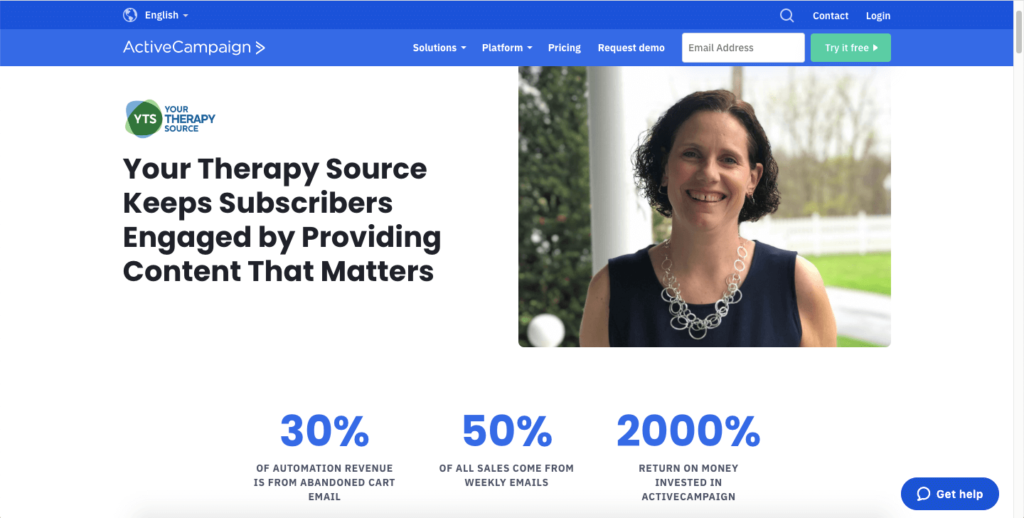Do you really need another piece of content to move leads through your sales pipeline?
With so much noise on social media platforms, many marketers might wonder if case studies are still relevant. The answer is yes, but only if they’re done right.
According to a 2024 survey from Statista, social media and video-sharing platforms are now the leading digital touchpoints for U.S. consumers, with 44% citing them as their primary interaction points. Ignoring these platforms means missing out on key opportunities to increase brand awareness and connect with potential customers.
Crafting a compelling social media marketing case study remains one of the best strategies for engaging future customers or digital agency clients.
But it’s not as simple as throwing together some numbers and calling it a day.
In this article, we’ll break down what makes a case study truly convert and how to strategically share it across social media channels. Plus, we’ll provide a template to help you get started.
Let’s jump in.
The importance of social media case studies in social media campaigns
There’s a lot of content out there.
Your potential customers are constantly bombarded with whitepapers, e-books, 10-step guides, newsletters and unpalatable sales hype. To get the attention of prospects today you have to demonstrate your product or service’s value, not just talk about it.
B2B buyers today don’t have time to interpret marketing messages that aren’t concise and relevant. That means that instead of aimlessly beating around the bush about how great your company is and how terrific your products are, you have to share the real-life experiences customers are having with you and your products.

Traditional marketing tactics don’t work anymore. We already know that. People nowadays drive their own buying decisions through online research, and the importance of social proof cannot be understated.
About 57% of the customers will only use or buy a business service if it has at least 4 or five-star ratings. It should be noted, however, that reviews aren’t enough. In fact, 88% of consumers view ratings and reviews as a personal suggestion, not definitive proof of a product’s efficacy.
Reviews are all good, but creating in-depth, data-driven case studies is the way to go if you’re marketing B2B software or digital marketing agency services. Case studies are extremely effective in the consideration stage of the buyer’s journey when they actively compare solutions and providers to solve a problem they’re experiencing.
Examples are many, such as:
- Digital marketing agency: A digital marketing agency can use a social media case study to showcase how they helped a small business refine its social strategy and achieve specific campaign goals. The case study can highlight key metrics and impressive results like engagement rates, website traffic, and new clients acquired. It provides prospects with clear evidence of the agency’s ability to deliver results and helping them evaluate their options when comparing service providers.
- Influencer marketing consultancy: An influencer marketing consultancy can create a case study demonstrating how they connected brands with influencers who resonated deeply with the target audience. The study can emphasize the types of content created, the campaign’s success in driving engagement, and how it generated buzz around the brand..
- B2B software provider: A B2B software provider can present a case study illustrating how their solution helped a client streamline content creation efforts, leading to significant efficiency improvements and a noticeable rise in website traffic. Such a real-world success story provides valuable social proof during the consideration stage.
- Social media management platform: A social media management platform can share a case study that outlines how a brand utilized the platform to create and manage social media content across multiple channels. The case study could highlight the resulting improvements in engagement rates and alignment with campaign goals – all to help prospects see how the platform stacks up against competitors in the market.
- Creative agency: A creative agency can use a case study to demonstrate how they developed a successful new campaign for a brand, tapping into the latest trends and content formats to capture audience interest. Such a study can focus on the measurable impact, such as increased brand visibility and the acquisition of new clients.
As we already mentioned, your prospects are actively researching your products, and there’s quite a chance that they will stumble upon content from your competitors. Relevant resources like case studies can cement your brand as an authority figure.
Now that you know why case studies are important, it’s time to tackle the creation process.
The ingredients for a perfect case study
1. Detailed and data-driven info
A great case study isn’t just a vague story of success – it’s built on concrete data. For example, instead of stating that a client “doubled traffic,” clarify what that actually means. Did visits jump from 50 to 100, or from 5,000 to 10,000? This level of specificity makes the impact of your work clear to prospective clients.
Highlight the exact ways your product or service made a difference. Include key metrics like a decrease in ad spend, an increase in organic followers, or improvements in engagement rates. Data like this gives your case study weight, especially for digital agencies where results speak louder than promises.
Remember, not everyone is an analytics expert. Break down complex data into digestible pieces so that anyone can understand the value of your work. Contextualize the numbers within the broader narrative to ensure they enhance your story rather than overwhelm the reader.
Checklist:
- Include specific metrics that clearly show the impact of your work.
- Simplify analytics and KPIs for a broad audience.
- Support data with visuals like graphs, real-time dashboards, or screenshots.
2. A compelling and complete story of a social media campaign
Storytelling allows your audience to connect emotionally and intellectually with your client’s journey. Begin with the customer’s challenges, walk through your solution’s impact, and finish with the results. This structure makes the story easy to follow and impactful.
When crafting your subject’s persona, focus on answering key questions: Who is the customer? What do they do? What were their goals and needs? The answers help paint a vivid picture that readers can relate to. Structure your narrative by splitting the main points into three clear sections: the challenge, the impact you had, and the final outcome.
A great story isn’t just about the hard facts—it’s also about the emotional benefits. Did your solution improve workplace morale, free up time, or reduce stress? Use quotes from the client to make the case study more personal and relatable. Additionally, include insights from your own team. Potential clients will appreciate learning how your team overcame specific challenges and delivered results.
Checklist:
- Structure the story with a clear beginning (challenge), middle (impact), and end (outcome).
- Include emotional benefits alongside data-driven results.
- Use quotes from both the client and your team to add a personal touch.
3. Relevant and engaging visuals
Visuals transform raw data into a more engaging experience. Each case study needs them! However, simply adding screenshots or images isn’t enough. The visuals need to be purposeful and align with your story.
Start with a catchy headline that clearly indicates what the case study is about. Then, arrange your visuals thoughtfully. Avoid cluttering the page. Leave plenty of negative space to keep the layout clean and easy on the eyes. Visuals should enhance the reader’s understanding of the data, not overwhelm them.
When gathering creative assets, focus on elements that genuinely add value. Include headshots of the actual customer to humanize the story, use dashboards of results to visually represent the data, and add screenshots of any relevant social media posts from the campaigns. If you’re looking to further engage your audience, consider multimedia elements like videos or interactive PDFs that make the content dynamic.
Checklist:
- Use visuals that enhance and complement the narrative and data.
- Include headshots, dashboards, and screenshots from relevant campaigns.
- Incorporate multimedia elements like videos or PDFs to increase engagement.
4. Personalization and audience relevance
We hate to break it to you – but your case study will be ineffective if it lacks relevancy and personalization. Your audience should see themselves in the story you’re telling.

When writing, always consider the specific industry, needs, and preferences of your target readers. The closer the match, the more impactful your case study will be.
If your audience is diverse, you may need to create multiple versions of your case study, each tailored to a different segment. For example, a visually-oriented client might appreciate a design-focused case study, while a data-driven client might prefer one packed with analytics. Personalization shows that you understand their unique challenges and can deliver customized solutions.
Finally, consider how your case study fits into the broader funnel. Readers of your case study are likely already familiar with your business and services. This is where you can really personalize the content to address their specific concerns and move them further along the buyer’s journey.
Checklist:
- Tailor each case study to your specific target audience.
- Create multiple versions for different client types or industries.
- Address specific concerns and demonstrate your understanding of their niche.
Various ways to deliver a social media marketing case study
If you just created an amazing case study that’s sure to knock readers’ socks off, you want people to find it. This means populating every channel at your disposal with your content so your potential customers can’t miss it.
YouTube social media case study
Youtube is the second-largest search engine in the world and the platform’s algorithm holds the potential to show your video to a whole new audience. While YouTube’s algorithm is often iffy, writing a catchy title, providing a detailed description, and creating an effective thumbnail are good ways to keep your video in the algorithm’s favor.
In addition, you’ll want to link your full case study in the comments and get viewers to land on your website. That can be a great starting point for your complex social media campaign.
For example, here’s an Instantly CRM case study on a highly profitable cold email strategy:

General social media case study
If you’re creating a social media case study, using social media to share said case study should be a no-brainer.
Break down the content of your case study into bite-sized chunks for Instagram or Facebook, post analytics dashboards from the study on Twitter, and link the study to a LinkedIn post to spice up your profile. The shareable nature of social media may lead to your case study going further than just your own site.
Embedded in other types of digital marketing content
Case studies can also be embedded in other types of content like blog posts, newsletters, guides or ebooks. Go through your current pieces of relevant content and link to your case study to provide extra value.
For example, Luzmo AI dashboard builder shared their case studies on YouTube, but embedded them in relevant blog posts on their site.
5 winning social media marketing case study examples
Now that we’ve gone over the components of a winning social media case study, let’s check out some real-world examples.
1. “How ERA Belgium Provides Great Content for Franchise Businesses with Kontentino,” by Kontentino

A thing to note regarding this case study is how Kontentino not only highlighted the impressive data but also how the product helped solve a core pain point for ERA Belgium’s franchises.
Highlighted in the middle of the case study is a bold quote from the client that helps solidify Kontentino’s KontentBase product as a must-have tool for franchises. When creating your own case study, consider your product and who’s needs it addresses. Align your customer quotes and data and results reports to match exactly what your target audience is looking for.
The Konetino case study also includes a CTA at the end so any potential prospects could directly contact the support team.
2. “How an SEO Agency Helped an Artisan Bakery Increase Organic Traffic by 214%,” is a very well written case study by Semrush
This comprehensive case study by Semrush is a perfect example of pinpoint narrative structure and proper formatting. The study flows like a well-written story and guides the reader through the subjects, conflicts and resolutions without a hitch. The tasteful addition of dashboards and bullet points ties the case study up perfectly.
3. “How Good Dye Young Increased Their Monthly E-commerce Revenue by 305%,” an impressive storytelling case study by Mailchimp
This case study by MailChimp is full of personality and storytelling. While MailChimp did include impressive numbers, the centerpiece of this case study is the people. The subjects in the case study are referenced casually by their first names, their journey is explored in-depth and there’s no shortage of quotes from them. The imaging MailChimp uses only emphasizes the human side of the relationship between them and the customer.
4. A set of Capsule CRM Customer Stories
Capsule CRM’s Customer Stories page turns business success into compelling narratives. It’s a showcase of real people achieving great things with the help of Capsule.

From creative startups to financial firms, each story pulls you in with bold visuals and headlines that spark curiosity. These stories give a behind-the-scenes look at how Capsule CRM integrates into different industries, helping clients manage relationships, streamline operations, and grow their businesses.
The message is clear: these companies made it work with Capsule, and so can you. At the end of each story, a call to action awaits, inviting readers to start their own journey.
5. Short and crisp – Localazy Case Studies
Localazy’s Case Studies go beyond highlighting results, focusing on the specific features that brought those successes to life.

They detail how companies like digital business card creators and real estate platforms easily solved their localization challenges. Localazy’s intuitive interface and translation management tools make expanding into global markets feel simple.
These case studies offer a behind-the-scenes view into how businesses use Localazy to grow and thrive, showcasing the platform as a vital tool for managing continuous localization efforts across diverse industries.
Keeping your social media strategy on track with your social media case study
So now you’ve got a solid idea of what a comprehensive case study should include and you’ve seen the techniques we’ve covered in action. Now it’s time to go over a full template to ensure you stay on track when creating your awesome social media case study.
Social media marketing case study template
Outline: Case Study Title
Customer: Customer’s full name
Company: Company’s name
Industry: The industry the customer operates in (if applicable)
Video: Link to a video version (if applicable)
Author: Author’s name
Case study title
Summary
A short introduction of the customer.
Be sure to highlight:
- The customer’s name and a little bit about them.
- Why you and your customer were a perfect fit
- The key successes your customer had after working with you
Introduce your customer
In this section, provide a more in-depth overview of your customer. If it’s an individual, explain the person’s background in the context of your product/service. If it’s a business, talk about the company’s background, industry and any recent successes or milestones they have had.
Describe the problem
Explain the challenge or opportunity your customers faced before they did business with you. This could be either a reactive reason (i.e. the customer had an issue that needed to be addressed) or a proactive reason (i.e. there was an untapped potential that was unleashed by working with your business).
Why (Customer Name) Chose (Your Company)
In this section, speak about your customer’s decision-making process. Speak about how they discovered you, your possible competition and what made them ultimately decide to do business with you.
How (Your Company) Responded
Here, explain what happened once your business started working with your customer. What was addressed first, and why? How did your customer feel about working with you in the early days?
The Results
In closing, speak to the results your customer saw after working with you. This section can be supported by statements, quotes, visuals, graphs, and metrics. Whatever you decide to include, be sure it illustrates how much of an impact your company made on your customer.
Call-to-Action
Use this section to move your readers down the funnel. Add a CTA that encourages readers to either join your newsletter or get in touch with your sales team.
Key takeaways
- A strong social media strategy is essential for crafting compelling case studies that resonate with your target audience.
- Highlighting success stories in social media campaigns helps build credibility and attract new clients.
- Data-driven case studies are powerful tools for showcasing the effectiveness of social media advertising efforts.
- Creating content that aligns with your client’s goals can significantly boost engagement and conversation with users.
- Case studies should focus on how small businesses leverage different types of social media strategies to achieve their objectives.
- Short paragraphs and clear visuals make your social media marketing case study more accessible and engaging for readers.
- When creating content for case studies, emphasize the specific interests of your audience to keep them engaged.
- Case studies are an excellent way to show how your social media strategy helped promote your client’s brand and generate results.
- Personalize your case studies to demonstrate how your approach can be adapted to different types of businesses and industries.
- Use quotes and real-life examples to make your case study more relatable, allowing your audience to see themselves in the story you’re telling.
Conclusion
Crafting a powerful social media case study is more than just data and stories – you have to show the potential within each success. Your next campaign could be the turning point that shifts the conversation and draws in new opportunities.
Once your case study is ready, use tools like Kontentino to share it strategically across social media channels, where it can reach the right eyes at the right time.
Now it’s your move – what story will you tell next?
FAQ
What are case studies in social media?
Case studies in social media showcase how a social media campaign or social media marketing strategy helped a business achieve its goals, typically through data, key metrics, and success stories, often improving website traffic or engagement.
What are some examples of case study studies?
Examples of social media case studies include successful social media campaigns where businesses improved website traffic, grew their following, or achieved digital marketing objectives through strategic social media advertising and tailored content creation.
How do you write a case study in social studies?
To write a case study in social media marketing, create content and focus on talking about the challenge, detailing the social media campaign, highlighting key metrics, and sharing the impact the campaign had on the business, all in a clear, concise format.
What are the studies about impacts of social media?
Studies on the impacts of social media often explore how effective social media campaigns influence digital marketing performance, from increasing engagement to driving website traffic and boosting overall brand visibility through targeted social media advertising efforts.







